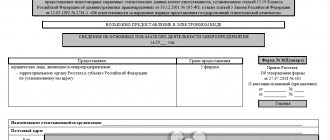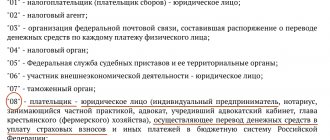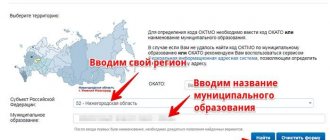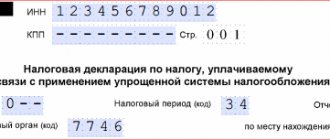The OKTMO code is a special digital designation that is assigned to each municipal entity in Russia. The OKTMO code in the 2021 payment order is entered in accordance with the Order of the Ministry of Finance No. 107n of 2013, which defines the basic rules for filling out payment orders. According to his instructions, all fields and lines of the payment must be filled out accordingly. If any mandatory details are not included in the document, the bank will not accept such an order for execution. Therefore, the territory code in the form OKTMO should always be indicated on the payment slip.
Where to find
To understand which OKTMO code to indicate in a payment order, you need to know that all the values of the codes in question are listed in the All-Russian Classifier of Municipal Territories - abbreviated OKTMO, which was approved on June 14, 2013 by order of Rosstandart No. 159-st. This reference book was adopted to replace OKATO - the classifier of administrative-territorial divisions. Thus, the question in itself disappears - what to indicate - the OKATO or OKTMO code in the payment order.
Please note that since the beginning of 2014, in tax returns and in payment slips, the value in field 105 has been entered in accordance with the OKTMO classifier. It represents the code of the municipality in which the organization operates or makes payments.
If an organization has separate divisions, which OKTMO should be indicated in payment orders when deducting contributions and taxes? Payments and declarations indicate the OKTMO code of the area where the “isolation” is located.
If the tax is transferred on the basis of a declaration, then the OKTMO code in the payment order is indicated in accordance with such a declaration.
The code in question consists of 8 or 11 digits. In accordance with the Classifier, the last 3 digits - from 9th to 11th - indicate a specific small settlement.
Any payer can find out his or the required OKTMO using a special service on the website of the Federal Tax Service of Russia www.nalog.ru. It allows you to determine the code using a directory through the name of the municipality.
Also see “Electronic services for accountants on the Federal Tax Service website: use wisely.”
There is a feature whose OKTMO is indicated in the payment order in relation to payments at customs. It is necessary to take the code of the territory that accumulates the corresponding payment.
Also see “Field 107 of the payment order: customs authority code”.
Find out OKTMO at the address
How to find out OKTMO by address? To do this, you can use the “Fill out a payment order” service on the Federal Tax Service website, in the “Electronic Services” section.
1. Select the taxpayer and payment document by placing dots in the appropriate checkboxes and click the “Next” button.
To find out OKTMO by address, just enter the address in the field provided.
2. Select the Federal Tax Service code from the presented directory.
3. Place a dot in the “Determine by address” checkbox.
4. Enter the address of the business and the system will automatically fill in the “OKTMO Code” field
You can also find out the OKTMO code by address in the Federal Information Address System https://fias.nalog.ru/.
Since 2021, due to the transformation of some municipal districts of the Moscow region into urban districts, OKTMO has changed. You can find out where this happened in the material “Starting from 2021, tax payments will have new OKTMO!”
To learn how to correct an error in the OKTMO code made when preparing the 6-NDFL form, read the article “How to correctly correct OKTMO in the calculation of 6-NDFL?” .
What to do if it is specified incorrectly
If the OKTMO code in the payment order is indicated incorrectly, this will not affect the receipt of tax to the budget. When an error is discovered in this detail, in accordance with clause 7 of Art. 45 of the Tax Code of the Russian Federation, an organization should contact the Federal Tax Service with an application to clarify the details. Such a petition is written in free form. In this case, the document must indicate:
- date of payment, transferred amount, purpose of payment;
- details that are specified incorrectly;
- the correct value of this attribute.
Along with the application you must submit:
- A copy of the erroneously completed payment slip.
- Statement of transfer of the amount.
In the event of an error in OKTMO in a payment order, the tax office may invite the organization to reconcile the calculations. The Federal Tax Service must make a decision no later than 10 working days from the date of receipt of the application from the organization, taking into account the execution of a settlement reconciliation report. The tax office is obliged to notify the payer of its decision.
Also see “Request for a reconciliation report with the tax office: changes since 2017.”
If the OKTMO code is entered incorrectly in the payment slip when paying insurance premiums in 2021, clarification of the payment is not required, since the Treasury does not take its value into account when distributing insurance premiums between budgets. This payment does not fall into the unknown, but will be taken into account in a special payment card with the budget, which indicates the OKTMO code at the place of activity of the organization.
Occasionally, OKTMO in a payment slip at the Pension Fund may have a zero value. This issue is regulated by clause 4 of Appendix No. 4 of Order No. 107n of the Ministry of Finance dated November 12, 2013.
Read also
13.07.2017
Tasks of the "OKTMO" classifier
The All-Russian Classifier code is required so that it is possible to identify the payment in the shortest possible time, as well as determine which municipal budget it should be sent to.
In 2021, we are still acting on the basis of Order of the Ministry of Finance No. 107 of 2013, which describes the principles for filling out payment orders. It is mandatory to write the OKTMO code, otherwise the bank will simply refuse to accept such a document. BEFORE 2014, it was necessary to enter a code according to the OKATO classifier, but it had a significant drawback - the inability to indicate an area within a city, a village or a hamlet. The OKTMO classifier is much broader, which allows for a more targeted distribution of money received into the budget from state duties.
The last three digits describe the subordinate locality.
Octmo when paying a traffic fine
If you made the payment online, it is recommended to download and print the resulting receipt - for example, in Sberbank Online it is saved as a graphic file. How to inform the traffic police about paying a fine?
There is no need to do this - banking organizations transfer data independently, without the participation of the payer. Another thing is that this may take 1-2 days.
If details are entered incorrectly, adjustments may be required.
There are several ways to restore lost details.
It is also possible to do without them - the driver does not really need them. If you have lost a receipt/order to pay a fine from the traffic police, where the details were indicated, you can check them at the nearest inspection office.
- Sberbank Online.
- In the form that appears, enter your personal data and email;
- In the activated “pay” line, select a convenient payment method;
- Enter the resolution number in the search bar of the “By Decree” tab by clicking the “Search” button;
- Confirm the correctness of the entered data;
- From the list of displayed fines, select those that need to be paid;
- A transition is made to the above payment system and payment is made.
Receipts for repayment of fines are sent automatically by the system to the user's email address.
Receipt and details for payment of fines from the State Traffic Safety Inspectorate of the UFC in Moscow (State Traffic Safety Inspectorate of the Ministry of Internal Affairs of Russia in the city).
Payment of the fine online to holders of Sberbank cards can be made using the Sberbank online service. Note! Late payment of fines not only deprives you of the 50% discount, but also leads to serious consequences.
Moscow (TSAFAP), l/sch No. 04731440640)
7 Specialized traffic police battalion of the State Traffic Safety Inspectorate on the special highway of the Main Directorate of the Ministry of Internal Affairs of Russia for Moscow (serves the third transport ring) Form No. 1 Notification Recipient of payment: Department of the Federal Inspectorate for Moscow (Ural State Traffic Safety Inspectorate of the Main Directorate of the Ministry of Internal Affairs of Russia for the city of Moscow)
Moscow (TSAFAP), l/sch No. 04731440640) INN: 7707089101 KPP: 770731005 Recipient bank: in Branch 1 Moscow settlement account: 40101810800000010041 BIC: 044583001 KBK: Fine for an administrative offense in the field of road safety (vv. 12.1-12.21, 12.22-12.32, 12.35-12.37) Fine for an administrative offense in the field of environmental protection (Art.
8.22, 8.23) Fine for violating the legislation on advertising (Article 14.37) Fine for violating the legislation on state control over international transport (Art.
11.23) Fine for violating the rules for transporting large and heavy cargo on federal roads (Article 12.21/1) Fine for violating the rules for transporting large and heavy cargo on roads of regional or intermunicipal importance (Art. 12.21/1) Fine for violating the rules for transporting large goods and heavy cargo on local roads of urban districts (according to Art.
12.21/1) Fine for violating the rules for transporting large and heavy cargo on local roads of municipal districts (Art.
12.21/1) Fine for violating the rules for transporting large and heavy cargo on local roads of settlements (Article 12.21/1)
Order for payment
Transfers of money within the payment system of the Russian Federation are accompanied by a specially drawn up document. Usually this is a payment order. For the purpose of filling out the details of such a form, the Bank of Russia has introduced a field called “Type of op.” – type of operation. What is the meaning and purpose of this field? Which of the required values must be entered into it on the payment order form in 2018?
Article 31 of the Federal Law of December 2, 1990 No. 395-1 “On Banks and Banking Activities” informs payers that settlements through credit institutions must be carried out on the basis of forms and standards established by the Bank of Russia.
In particular, it stipulates the direct obligation of the bank to transfer the client’s money. And, having received the necessary payment document, credit them to the appropriate account within 1 business day (if there are no other deadlines specified by law).
If a credit institution fails to comply with this requirement or debits money from the account by mistake, it will have to:
- return funds back;
- pay interest according to the refinancing rate.
The rules for filling out the payment order form, as well as the specifics of its details, are stipulated by the rules according to which money transfers occur in Russia. These Rules were approved by the Central Bank on June 19, 2012 under number 383-P.
Each detail in a payment order is important and affects:
- for the correct identification of the payment by the financial institution;
- exact execution of the payer’s decision to transfer money.
When an error is made when filling out the fields of the payment form, the money:
- Or they will go to the wrong recipient.
- Or the payment will be incorrectly identified (frozen).
The mentioned Rules No. 383-P in Appendix 1 to them provide a list of all necessary details and their disclosure, as well as what they mean.
The current payment form contains details for various purposes. Among them is “View op.” Completely – this is the type of transaction in the payment order. It is entered in field No. 18 of the payment order:
Let's name other basic payment details:
| Props | What does it include |
| Payer information | Company name or last name, first name and patronymic of an individual (p.  |
| Checkpoint – reason code for setting (page 102) | |
| TIN (page 60) | |
| Payer bank details (pages 9 – 12) | |
| Information about the recipient of funds | Name of the enterprise or last name, first name and patronymic of an individual (page 16) |
| Checkpoint (page 103) | |
| TIN (page 61) | |
| Recipient's bank details (pages 13,14,15 and 17) | |
| Information about the payment itself | The amount only in domestic currency is entered in lines 6 and 7 |
| KBK when making payments to the budget system (p. 104) | |
| Purpose of the money transfer (page 24) |
Where can I get the details to pay a traffic fine?
Contents You can clarify the traffic police details for paying a fine in a variety of ways. Some of them work online, and some only offline.
If the payment form issued by the inspector is lost, then this is not a reason not to pay the fine, since it can be restored. What to do if the resolution was lost? If the driver has lost the form, this does not relieve him of his obligation to pay fines.
If you ignore the payment requirement, you can get into quite serious problems. In the mildest case, this will be an additional fine, and administrative arrest is also possible. Therefore, it is better not to lose the receipt issued by the inspector, but to immediately use it by making payment.
Where can I get a copy of the receipt/order if it has been lost?
There is nothing complicated about this; you can restore it in the following ways:
- By contacting the traffic police department. By contacting the inspector on the road. Using the search for traffic police fines on the official website of the inspectorate.
Payment without details is also possible. The traffic police details for paying a fine have a clear structure. However, they are not universal - they are different in each department.
The details contain the following data: name of the payment recipient - for example, the Department of the Ministry of Internal Affairs of Russia for the city of Volgograd; Recipient's TIN - individual taxpayer number (accordingly, this is the TIN of the above organization); KPP – reason code for setting, corresponds to the legal entity; name of the recipient's bank - for example, GRKTSGU Bank of Russia for the Volgograd region.
What is the difference and how to recognize okato?
What is the difference between OKATO and OKTMO? Basically, these systems are very similar to each other and in fact, the difference between both systems is not that great. Both identifiers serve to describe the characteristics of an object according to its belonging to any territorial entity and, for the most part, structurally differ very slightly, even complementing each other.
The most important difference between OKATO code and OKTMO code is the search algorithm in their database. If in OKATO the main feature characterizing the search object was its affiliation with any subject of the federation, then in OKTMO the search is carried out in the direction of determining subordination in the hierarchy of municipal associations.
By the way, you can find out about okato using the form on our website.
Municipalities and related territorial entities are divided in accordance with the Federal Districts.
Units of territorial entities that are subjects of OKTMO:
- Municipal areas;
- Urban districts;
- Urban settlements;
- Rural settlements.
The demarcation and division of powers between municipalities is carried out by local government bodies. To reduce confusion, documents often contain a definition - territorial entity.
Territorial entities are classified according to hierarchical methods (OKTMO):
- Grouping of entities of the constituent entities of the Russian Federation;
- Urban districts with division at the application level;
- Urban settlements, districts and rural formations.
Code structure
The structure of the OKTMO code at the address ranges from 8 to 11 digits.
Each of the characters has a specific purpose depending on its location in the code:
- The first and second digits of the code indicate the subject of the Russian Federation;
- The third, fourth and fifth digits are the encoding of a locality within a specific subject;
- The sixth, seventh and eighth categories are urban or rural districts;
- The ninth, tenth and eleventh ranks are the designation of the territory in the local municipal structure.
According to previously adopted rules, when OKATO was in effect, all insignificant digits had to be filled with zero values. In OKTMO, it is enough to enter dashes in place of the unused digit. One of the main reasons for developing a replacement for OKATO is the lack of a way to check its correct spelling.
OKTMO is free of this drawback thanks to the introduction of checksum verification. The changes associated with the replacement of classifiers do not apply to filling out tax returns for all types of taxes.
For the current 2021, OKTMO by oktmo has already become the main identification code for determining it in information statistical databases and has completely replaced OKATO when filling out financial documents.
Historical reference
Previously, cumulative databases of business entities were used to record and systematize information. Only they looked like tax books, and not like information on the hard drives of the tax service.
Back in the days of ancient Egypt, the first graphs were drawn and economic indices were calculated, but there was not the slightest chance to predict the massive economic component of the ongoing processes due to the shortcomings of manual recording of source data. In this regard, attempts were made to divide business entities on a territorial basis and introduce systematization of their accounting for the purpose of tax and financial control. This is how, for example, the Golden Horde acted, issuing labels in the occupied lands, dividing them in order to streamline the payment of taxes in a certain area.
Where to get bank details to pay traffic fines
You can clarify the traffic police details for paying a fine in a variety of ways. Some of them work online, and some only offline.
If the payment form issued by the inspector is lost, then this is not a reason not to pay the fine, since it can be restored. What to do if the resolution was lost? If the driver has lost the form, this does not relieve him of his obligation to pay fines.
If you ignore the payment requirement, you can get into quite serious problems.
In the mildest case, this will be an additional fine, and administrative arrest is also possible. Therefore, it is better not to lose the receipt issued by the inspector, but to immediately use it by making payment.
We recommend reading: How and where to apply for divorce in Saratov
Where can I get a copy of the receipt/order if it has been lost?
There is nothing complicated about this; you can restore it in the following ways:
- By contacting the traffic police department. By contacting the inspector on the road. Using the search for traffic police fines on the official website of the inspectorate.
Payment without details is also possible. The details for paying for an offense have a clear structure.
However, they are not universal - they are different in each department. The details contain the following data: name of the payment recipient - for example, the Department of the Ministry of Internal Affairs of Russia for the city of Volgograd; Recipient's TIN - individual taxpayer number (accordingly, this is the TIN of the above organization); KPP – reason code for setting, corresponds to the legal entity; name of the recipient's bank - for example, GRKTSGU Bank of Russia for the Volgograd region.
OKTMO in a payment order in 2021
The corresponding field 105 in the payment order is filled in only when paying taxes or insurance premiums. In other cases, for example, when making payments to suppliers, this column remains empty. The OKTMO classification was developed by Rosstandart in order No. 159-st dated June 14, 2013. The current digital codes of municipalities (municipalities) serve to territorially designate the taxpayer’s activities and are used in 2021 instead of the previously relevant OKATO.
The size of the code varies and can be either 8-digit for inter-populated areas and municipalities, or 11-digit for populated areas. For example, OKTMO of the Rostov region is 60701000, and OKTMO of the village of Kushchevskaya, Krasnodar Territory is 03628416101. 8-digit codes are mainly used to designate MO. If it is necessary to identify a specific locality - village, village, etc., then an additional 3-digit encoding is added. How to correctly fill out field 105 in a payment order?
Where can I get the details to pay a traffic fine?
Contents Usually, the traffic police details for paying a fine are indicated on the receipt. But it often happens that drivers lose this document.
The situation is not at all hopeless.
There are various options that will relieve you of the threat of late payments. You can carry out a transaction to pay off a debt through a terminal or on the Internet. To figure out how to find out the bank details of the traffic police to pay a fine according to the number of the order issued to you, you can go to the State Services Internet resource (more about checking fines at the State Services).
There you will be asked to enter the state number of the car and the driver's license number in special fields.
You only need to wait a few minutes to see the list of debts to be paid.
You can then print out the receipt or rewrite the required data. Using the Government Services Portal requires the presence of a personal account on it.
For those who need to sort out payment of foreclosures urgently, there is a more accessible option. The ability to find a fine based on the data of a car or its owner and immediately make payment is provided by almost every bank. So, use the nearest terminal to get the details for paying the traffic police fine and the amount to be paid.
The advantage of this method is that you can use not only the decree number, but also cars, IDs or passport details if the payer is a pedestrian.
Banking institutions also provide the opportunity to track debts on their online services and immediately repay them by transferring funds from the card.
OKTMO: how and where to reflect
OKTMO is a code assigned to the territory of a municipality or a settlement that is part of it. In tax returns and payment orders for the transfer of tax payments and insurance premiums, it is necessary to indicate OKTMO of the territory in which the corresponding taxes, fees or contributions are accumulated.
Let's analyze the situation.
In 2021, 2 friends each opened their own business in the Eastern District of Moscow: one organized Sadko LLC in Novogireevo, and the other created IP Zakharov M.N. in the village. Akulovo. They had not been involved in business before and became acquainted with all the intricacies of difficult commercial work in the process of their activities.
At the initial stage of work, both of them kept their own accounts, so when it came time to transfer the first tax payments, everyone thought about how to fill out the payment slip correctly - there were too many codes and ciphers in it.
Read more about decoding the fields of a payment order in the material “How to decrypt a payment order?”.
Friends meticulously tried to understand the intricacies of the contents of this payment document. The basis was taken from the main regulatory document defining the requirements for filling out payment slips when paying taxes - Order of the Ministry of Finance of Russia dated November 12, 2013 No. 107n on the rules for filling out information in payment orders for the transfer of tax payments. And for control, we checked with a ready-made sample taken from the Internet.
Both had to work hard to complete the payment slips: indicate the 20-digit current account numbers without errors, unravel the incomprehensible coded words (KBK, OKTMO, BIC). Finally, this difficult process was completed, and both friends met to reconcile their bills - as a control step before sending them to the bank.
We'll tell you what came out of this later.








